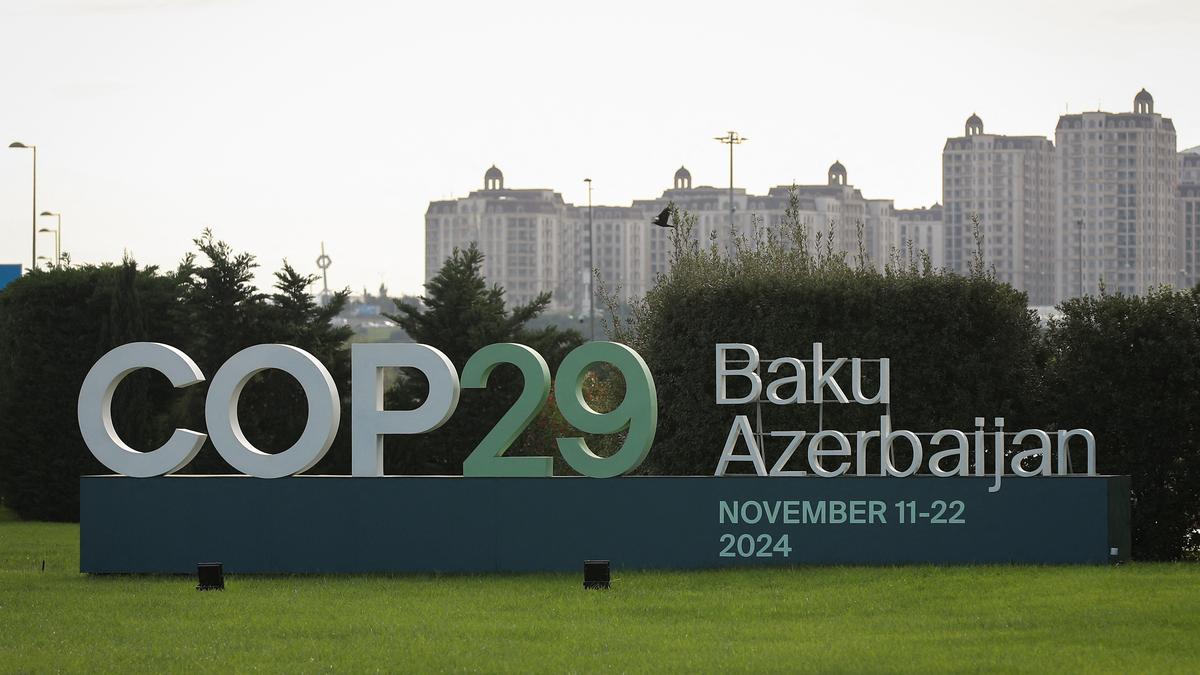Zeroing in on Methane Diplomacy, at COP29

- 07 Nov 2024
In News:
From November 11 to 22, 2024, global leaders will gather in Baku, Azerbaijan, for the 29th Conference of Parties (COP29) under the United Nations Framework Convention on Climate Change (UNFCCC). This year’s summit, known as the Finance COP, will focus on setting a new global climate finance target—the New Collective Quantified Goal (NCQG).
A key focus of the summit is the reduction of methane emissions, as countries aim to curb near-term temperature increases, which buys critical time for long-term CO2 reductions necessary for stabilizing climate change.
U.S.-China Collaboration and Methane Reduction
US-China Collaboration Despite Geopolitical Tensions
Despite ongoing geopolitical tensions, the United States and China have found common ground on the issue of methane reduction. Both nations recognize the importance of addressing methane emissions, which are more potent in the short term than CO2. They, along with the United Arab Emirates, organized a summit at COP28 to discuss methane and other non-CO2 pollutants.
China’s National Plan for Methane Emissions
In November 2023, China launched its first national methane reduction plan, emphasizing capacity-building efforts over explicit reduction targets. This plan marked a significant step in China’s climate policy, underscoring its commitment to mitigating methane emissions alongside the U.S.
Given that China and the U.S. are the two largest contributors to methane emissions globally, their collaboration presents a significant opportunity for global climate mitigation efforts. India, the third-largest emitter of methane, could benefit from this partnership by seeking financial support and technical expertise to address its methane challenges.
India’s Methane Emissions Profile and Challenges
Emissions Breakdown
India’s Third Biennial Update Report to the UNFCCC indicates that in 2016, India emitted approximately 409 million tons of CO2-equivalent methane. The major sources of these emissions include:
- Agriculture: 74% (mainly from livestock and rice cultivation)
- Waste: 14% (unmanaged organic waste in landfills and dumpsites)
- Energy: 11%
- Industrial processes: 1%
Due to the dominant role of agriculture, India has been cautious about committing to stringent methane reduction targets. Initiatives like the Global Methane Pledge, which calls for a 30% reduction from 2020 levels by 2030, have not been fully embraced.
Environmental and Health Impact of Methane Emissions
Methane-related fires at waste dumpsites, such as the Bhalswa dump in Delhi (2022), have highlighted the broader environmental and health risks of methane emissions. These fires contribute significantly to air pollution, making it urgent for India to address methane in its waste management and agricultural sectors.
India’s Initiatives for Methane Reduction
Waste Management Programs
- Comprehensive Waste Management Framework India’s waste management sector is a significant source of methane, contributing 14% of the nation’s total emissions. Although a comprehensive regulatory framework for waste management has been developed, implementation remains slow due to local capacity constraints and financial limitations.
- Innovative Solutions Indore, a city in Madhya Pradesh, has pioneered waste sorting and biomethane production. The city's initiative includes:
- Sorting organic waste
- Converting it into biogas to fuel city buses
This model has gained national attention and is being considered for replication in other cities.
- GOBARdhan Scheme Launched as part of the Swachh Bharat Mission-Urban 2.0, the Galvanizing Organic Bio-Agro Resources Dhan (GOBARdhan) scheme encourages rural communities to convert cattle manure and other organic waste into biogas and compost, reducing methane emissions from livestock waste while providing additional income to rural households.
Agricultural and Livestock Emission Reduction
- National Mission for Sustainable Agriculture (NMSA) The NMSA promotes climate-resilient agricultural practices that reduce methane emissions. For example, Alternate Wetting and Drying (AWD) is a water-saving technique used in rice farming that reduces methane emissions by limiting anaerobic decomposition.
- National Livestock Mission Under the National Livestock Mission, practices such as improved fodder management, silage making, and Total Mixed Ration (TMR) feeding are being promoted. These practices reduce methane emissions from livestock by improving digestion and feed efficiency.
Opportunities for India at COP29
Leveraging U.S.-China Methane Partnership
COP29 offers India an opportunity to leverage the U.S.-China collaboration on methane reduction. By engaging with these two major emitters, India can seek:
- Financial support
- Technical assistance
- Capacity-building resources, particularly for its waste sector, which is a significant source of methane emissions.
Accurate data on methane emissions, such as satellite-based monitoring, can help India refine its emission inventories and enhance the effectiveness of its methane mitigation efforts.
Fast-Tracking India’s Methane Reduction Efforts
Although methane is not the primary focus at COP29, India has an opportunity to fast-track its efforts in methane reduction. The country's existing policies and initiatives, such as waste management programs and agricultural missions, provide a foundation upon which international collaboration can build.
Recent data from satellite monitoring in cities like Delhi and Mumbai shows that actual methane emissions from waste dumpsites may be 50%-100% higher than previously estimated, highlighting the urgency of addressing this issue.
Conclusion
Although methane may not dominate the COP29 agenda, it represents a critical pathway for India to accelerate its climate action. With the groundwork already laid through domestic policies and innovative solutions, India now requires enhanced financial and technical backing to scale up its methane reduction initiatives. By engaging proactively at COP29, India has a unique opportunity to secure the resources needed to tackle methane emissions, benefiting both its citizens and the global fight against climate change.
